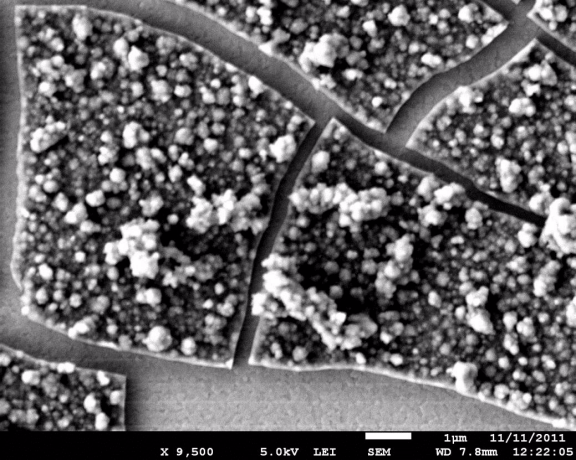Hydrogen is a clean fuel, producing only water vapor when it burns. But generating hydrogen in large quantities and in a “green” fashion is not straightforward.
Biological photosynthesis includes an efficient reaction step that splits water into hydrogen and oxygen with the help of catalysts that have been used as models for synthetic catalysts.
Working at the U.S. Department of Energy’s Advanced Photon Source (APS) at Argonne National Laboratory, a team of Argonne scientists has determined the structure of one such catalyst, a complex cobalt oxide. The material is composed of crystalline domains containing just 13 or 14 cobalt atoms, with distortions at their boundaries that may be important for its catalytic properties.
The water-splitting cobalt oxide catalyst was discovered serendipitously about three years ago, in experiments where an electric current ran through a solution containing dissolved cobalt salts. Because of the amorphous nature of the catalyst film, the details of its structure have remained unclear.
Previous x-ray and other spectroscopy studies showed that cobalt in the catalyst exists in an octahedral coordination environment, CoO6, with Co at the center and O at the vertices. This conformation is analogous to the lattice sheet domains of the non-catalytic crystalline cobalt oxides, but is present here in domains of undetermined molecular-scale dimensions.
However, some earlier publications suggested that the x-ray spectroscopy data could also be interpreted in terms of cobalt oxide cubane structures, Co4O4, that are analogous to the structure and spectroscopy of the water-splitting catalyst that occurs in biological photosynthesis systems.
The Argonne researchers prepared the cobalt oxide material by electrodeposition from a solution buffered with potassium phosphate.
Working at X-ray Science Division x-ray beamline 11-ID-B at the APS, they conducted x-ray diffraction studies on samples in the form either of dry powder or aqueous slurry.
The amorphous nature of the catalyst’s composition makes it impossible to infer definitive crystallographic structure from standard diffraction measurements. Instead, the researchers used a straightforward mathematical technique – essentially a Fourier transform – to turn the observed x-ray scattering data into the electron pair density distribution function, which appears as a series of peaks corresponding to a set of distances between the atoms in the structure.
Interpreting the results was then a matter of modeling the expected pair distribution function (PDF) from a supposed structure and seeing how well it fit the experimental data.
The researchers found that the best fit came from structures with domains consisting of CoO6 octahedra with shared edges, and careful analysis allowed them to deduce the most likely number of cobalt atoms in the domains. Domains with 12 cobalt atoms or fewer didn’t fit the PDF for interatomic distances greater than about 10 Å, while domains with 15 or more cobalt atoms failed to match the PDF at smaller distances.
The team thus concluded that each domain in the amorphous material must have 13 or 14 cobalt oxide octahedra.
The model-fitting exercise also revealed some characteristic differences between the pair distribution functions observed experimentally and those calculated using crystalline lattice models for the domains, demonstrating that the structure for the lattice domains in the catalyst differs from those of non-catalytic crystalline cobalt oxides.
The analysis showed that slight alterations to the coordination geometries for the oxygen atoms bound to the cobalt atoms at the edges of the domains (for example a 4o shift from their normal positions) could account for most of the discrepancy between the experimental and model structures.
Cubane-type inclusions were also found to be possible additional sparse defects that could bring experiment and model into better alignment. Also significant was the finding that phosphate anions, which are required for catalytic activity, were detected as disordered constituents of the film.
Ongoing work is investigating the correlation between structure and catalytic function of the cobalt oxide catalysts, and developing more highly refined models.
The researchers suggest that the distorted cobalt coordination geometries in the catalyst may be a distinguishing feature that confers the ability to catalyze the water-splitting reaction compared to the non-catalytic crystalline cobalt oxides, although Chupas acknowledges that this suggestion is somewhat speculative.
“It will take a while to figure out the [catalytic] mechanism,” he says, but it’s crucial to know the structure of the material and “this is the best structure that’s out there right now.”
— David Lindley
See: Pingwu Du, Oleksandr Kokhan, Karena W. Chapman, Peter J. Chupas, and David M. Tiede*, "Elucidating the Domain Structure of the Cobalt Oxide Water Splitting Catalyst by X-ray Pair Distribution Function Analysis," J. Am. Chem. Soc. 134, 11096 (2012).
DOI:10.1021/ja303826a
Author affiliation: Argonne National Laboratory
Correspondence: *[email protected]
Use of the Advanced Photon Source at Argonne National Laboratory was supported by the DOE’s Office of Science under Contract No. DE-AC02-06CH11357.
The Advanced Photon Source at Argonne National Laboratory is one of five national synchrotron radiation light sources supported by the U.S. Department of Energy’s Office of Science to carry out applied and basic research to understand, predict, and ultimately control matter and energy at the electronic, atomic, and molecular levels, provide the foundations for new energy technologies, and support DOE missions in energy, environment, and national security. To learn more about the Office of Science x-ray user facilities, visit http://science.energy.gov/user-facilities/basic-energy-sciences/.
Argonne National Laboratory seeks solutions to pressing national problems in science and technology. The nation's first national laboratory, Argonne conducts leading-edge basic and applied scientific research in virtually every scientific discipline. Argonne researchers work closely with researchers from hundreds of companies, universities, and federal, state and municipal agencies to help them solve their specific problems, advance America's scientific leadership and prepare the nation for a better future. With employees from more than 60 nations, Argonne is managed by UChicago Argonne, LLC for the U.S. Department of Energy's Office of Science.

